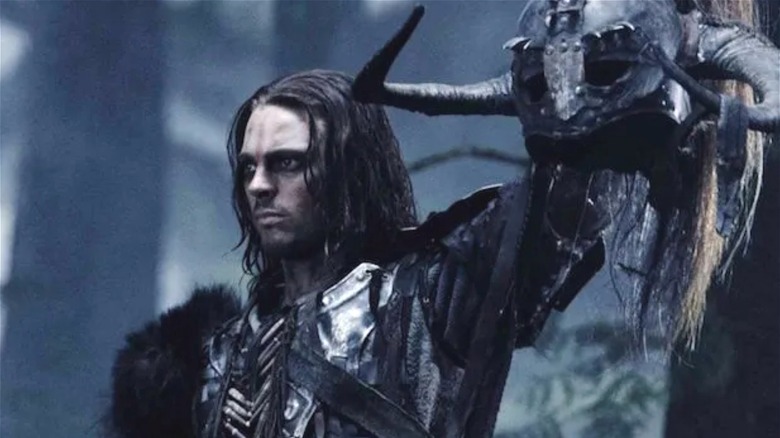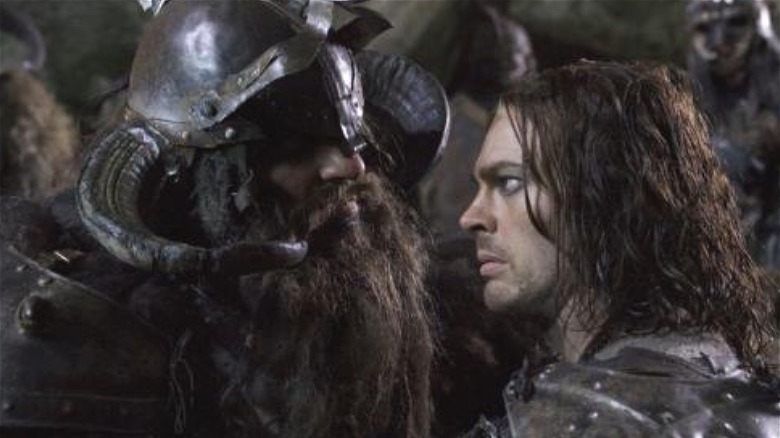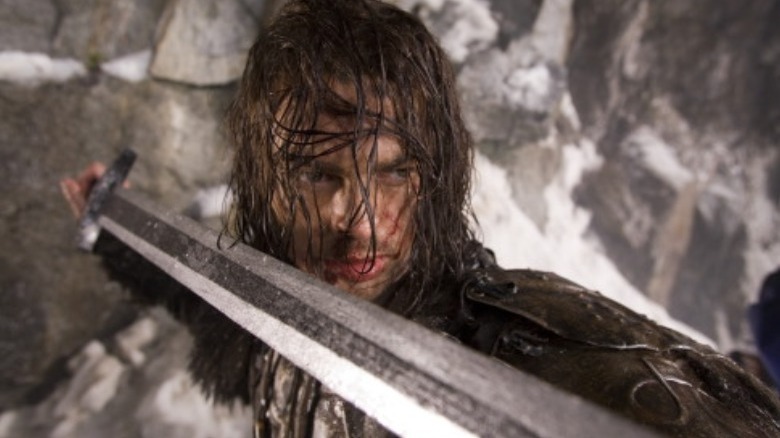Why Karl Urban Considers Pathfinder More Challenging Than Shooting Lord Of The Rings
Karl Urban has brought several seminal characters to life. Apart from playing the complex, unhinged role of Billy Butcher in "The Boys," Urban has been a part of several major franchises over the course of his career, including "Star Trek" and "The Lord of the Rings." Peter Jackson's 2002 film "The Lord of the Rings: The Two Towers" was a breakout film for Urban, in which he played Éomer, a leader of the Riders of Rohan who went on to become the King of Rohan. Almost every scene featuring Éomer is battle-intensive, as his character is instrumental in the Battle of Helm's Deep. While one would think that "The Two Towers" would be one of the most challenging shooting experiences for Urban, the actor revealed in a 2007 interview with IGN that it was not the case.
In 2007, Urban starred in an overlooked summer film named "Pathfinder," directed by Marcus Nispel, who had previously helmed "The Texas Chainsaw Massacre" remake in 2003. Nispel's film was loosely inspired by a 1987 Norwegian film of the same name and centered on Ghost (Urban), the survivor of a Viking invasion who is raised by a Native American tribe. "Pathfinder" is an extremely violent Viking story that is not historically accurate by any means, but one that attempts to find its footing with the help of high-velocity action alone. While the film was both a box office and critical dud, Urban describes the on-set risks while shooting for "Pathfinder" and how it was "more challenging" than shooting anything for "The Two Towers."
A constant uphill battle
"Pathfinder" was shot in Vancouver during winter, against the backdrop of real forests and slippery hills. While this worked fairly well in favor of the film's premise, the on-set conditions were extremely risky for the cast and crew. Moon Bloodgood, who played Starfire, told MTV that people got routinely hurt "because of very sketchy conditions" and that someone got "stabbed on accident" (!) during a fight scene.
In the IGN interview, Urban explained that after all the interior scenes were shot, the rest of the shoot was "100% on location," which was "grueling" for him in particular, as his role was physically demanding. The rest of the crew also suffered, as 13 members got injured while scoping out a cave location, and it was common for folks to have twisted ankles or bruised limbs while traversing the rough topography. Urban said:
"It was challenging at the time but, certainly, some locations were very dangerous. Thirteen members of our crew got injured while we were working in the cave system, either smacking into the roof of the cave or twisting their ankles on the slippery rocks. So it was a pretty tough, dangerous set at times."
When compared to "The Two Towers," in which Urban had to enact a key role during the "fierce, prolonged battle" of Helm's Deep, the action scenes in "Pathfinder" were more challenging due to the physical risks attached to them. The reasons were manifold. Firstly, Urban had more to do in "Pathfinder," and unlike the epic battle in "The Two Towers," in which many characters took center stage at once, the fight scenes in "Pathfinder" were exclusively focused on Urban. Moreover, the adverse weather conditions led to him "sustaining injuries" throughout the course of the shoot.
Pathfinder was a rewarding experience for Karl Urban
One of the biggest criticisms of "Pathfinder" was the film's insistence on prioritizing action over character development. This led to a lackluster plot with zero emphasis on meaningful stakes. However, "Pathfinder" has a certain music video appeal to it, as it uses slow-motion to exaggerate ruthless fights and blasts nu-metal over strikingly beautiful landscapes. The dialogue in the film is sparse, which is not always a bad thing, but in this case, it only allowed the cast to express themselves through over-the-top physical maneuvers in a challenging environment. However, Urban saw this aspect as a strength for "Pathfinder," as he deems it a "rewarding experience" due to the challenges it posed. He said:
"It's not a dialogue-driven film. It's an action-driven film and I like that because when I was training in my craft, I was taught an ounce of action is worth a pound of words. If I can convey an emotion or a meaning through a look without a big soliloquy, then great."
Apart from this, Nispel worked meticulously to set up the shots for "Pathfinder," as he wanted to use multiple setups to convey the dynamic nature of the violence and gore in the film. Urban addressed this as well, saying that "every element in the frame" was carefully composed, which added to the difficulty of certain scenes. For instance, the avalanche scene, although polished mostly in post production, had to be simulated to some extent amid real weather conditions. Nispel's insistence on multiple setups added another challenging layer to an already rough shoot, but Urban does believe that it was worth it in the end.


